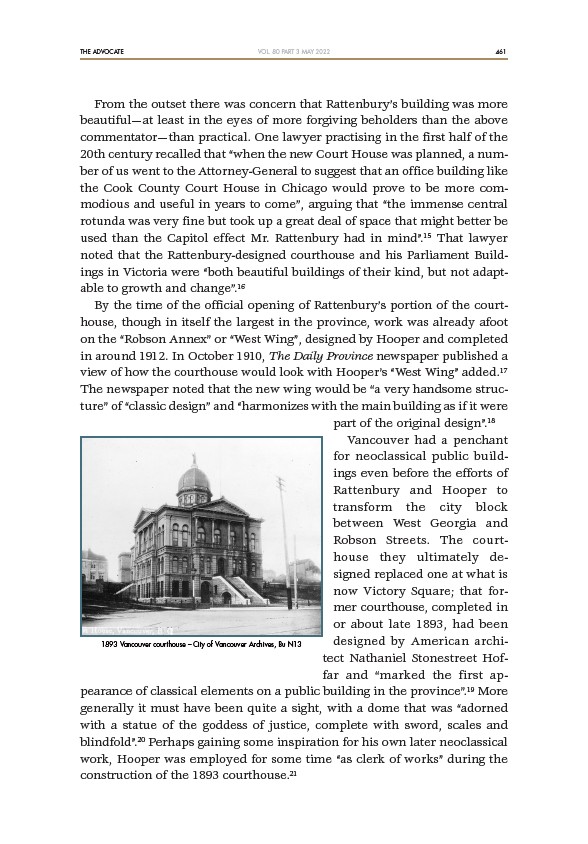
THE ADVOCATE 461
VOL. 80 PART 3 MAY 2022
From the outset there was concern that Rattenbury’s building was more
beautiful—at least in the eyes of more forgiving beholders than the above
commentator—than practical. One lawyer practising in the first half of the
20th century recalled that “when the new Court House was planned, a number
of us went to the Attorney-General to suggest that an office building like
the Cook County Court House in Chicago would prove to be more commodious
and useful in years to come”, arguing that “the immense central
rotunda was very fine but took up a great deal of space that might better be
used than the Capitol effect Mr. Rattenbury had in mind”.15 That lawyer
noted that the Rattenbury-designed courthouse and his Parliament Buildings
in Victoria were “both beautiful buildings of their kind, but not adaptable
to growth and change”.16
By the time of the official opening of Rattenbury’s portion of the courthouse,
though in itself the largest in the province, work was already afoot
on the “Robson Annex” or “West Wing”, designed by Hooper and completed
in around 1912. In October 1910, The Daily Province newspaper published a
view of how the courthouse would look with Hooper’s “West Wing” added.17
The newspaper noted that the new wing would be “a very handsome structure”
of “classic design” and “harmonizes with the main building as if it were
part of the original design”.18
Vancouver had a penchant
for neoclassical public buildings
even before the efforts of
Rattenbury and Hooper to
transform the city block
between West Georgia and
Robson Streets. The courthouse
they ultimately designed
replaced one at what is
now Victory Square; that former
courthouse, completed in
or about late 1893, had been
designed by American architect
Nathaniel Stonestreet Hoffar
and “marked the first ap-
1893 Vancouver courthouse – City of Vancouver Archives, Bu N13
pearance of classical elements on a public building in the province”.19 More
generally it must have been quite a sight, with a dome that was “adorned
with a statue of the goddess of justice, complete with sword, scales and
blindfold”.20 Perhaps gaining some inspiration for his own later neoclassical
work, Hooper was employed for some time “as clerk of works” during the
construction of the 1893 courthouse.21